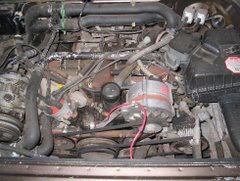President Bush enjoyed a high-profile photo-op Monday with the
heads of the Big Three automakers and their latest clean-car models. The
impressive lineup included a General Motors model that can run on
ethanol, a plug-in Ford powered by hydrogen, and a DaimlerChrysler Jeep
filled with a biodiesel blend.
But there's a dirty secret about clean cars. The policies for flexible-fuel vehicles—those that can run on mixtures of gasoline and more than 10 percent ethanol—are written in such a way that they result in a number of unintended consequences. One result is that automakers gain some leeway in meeting fuel-economy standards if they produce flexible-fuel cars and trucks. So Detroit's automakers have been pumping out hundreds of thousands of the vehicles, even though most consumers have no access to alternative fuels because they're available at only a fraction of U.S. gas stations.
Here's why that's an issue. Automakers need to meet certain government standards for the fuel economy of their fleets. For flex-fuel cars, fuel economy is calculated based on the assumption that their owners use 50 percent gasoline and 50 percent ethanol. But the reality is that just 1 percent of the nation's flexible-fuel vehicles actually use what's known as E85—85 percent ethanol and 15 percent gasoline. The remaining 99 percent are using good old-fashioned gasoline.
More greenhouse gases
The result is anything but green. The more flex-fuel cars and trucks that are produced, the more gasoline is consumed—dramatically increasing greenhouse gas emissions and deepening the country's dependence on petroleum. The Union of Concerned Scientists estimates that without the policy in place, the U.S. would have burned 4 billion fewer gallons of gasoline since 1998. "Automakers have an [economic] incentive to sell cars less efficient than the law requires," says Don MacKenzie, a vehicles engineer for the Union's clean vehicles program.
Environmental advocates aren't shy about voicing their outrage. "It's a total scam," says Dan Becker, director of the Sierra Club's global warming program. "The automakers are trying to shield themselves from having to make more efficient vehicles. They're avoiding the path to cutting oil dependence, curbing global warming, saving consumers money, and ultimately saving Detroit from competitors like Toyota."
The culprit is a 1988 law called the Alternative Motor Fuels Act, which has been extended through 2008. It gives automakers extra credit toward meeting fuel-economy standards for making cars that can run on alternative fuels. It's cheap for automakers to make cars fuel-flexible; it only costs them about $50 per vehicle, whereas actually meeting fuel-economy standards (making cars travel more miles per gallon) can be much more expensive. So in recent years auto companies have been pouring out flexible-fuel, gas-guzzling sport-utility vehicles without worrying too much about fuel economy.
Shortage of ethanol pumps
But, as the Bush administration itself acknowledged in 2002, the consumers who own flex-fuel cars aren't going for alternative fuels. Ethanol-based fuels like E85 are hard to come by, and are only available in certain regions of the country. Only 1,600 of the nation's 176,000 gas stations pump E85, the most popular and commercially viable alternative fuel, says the National Ethanol Vehicle Coalition. So the more flexible-fuel vehicles that hit the road without an ethanol pump in sight, the more pure gasoline Americans continue to guzzle.
Ethanol advocates say fuels like E85 are a right-here-right-now solution to reducing oil dependence. "[T]here's nothing that can be done which can reduce the curve of growth in imported oil and actually turn it down like using E85, taking advantage of what's there today," said GM Chairman and Chief Executive Officer G. Richard Wagoner Jr. at the White House event.
They also argue that the mismatch between the size of the flexible-fuel fleet and the availability of ethanol will be solved over time. "You've got to get started somehow," says Phillip Lampert, executive director of the NEVC. Lambert points out that the number of gas stations providing E85 has doubled in the last year, and his group—backed by automakers and ethanol producers—is pushing for bigger tax incentives for fuel retailers.
Still, the conversation that Bush and the Big Three avoided was talk of fuel economy. In the short term, it's far cheaper for car companies to keep producing cars that seem environmentally friendly than to re-engineer cars to squeeze out more miles per gallon. Until the U.S. has much broader availability of alternative fuels, old-fashioned gas guzzling will continue to rise into the not-so-green future.
Copyright © 2012 Bloomberg L.P. All rights reserved.






